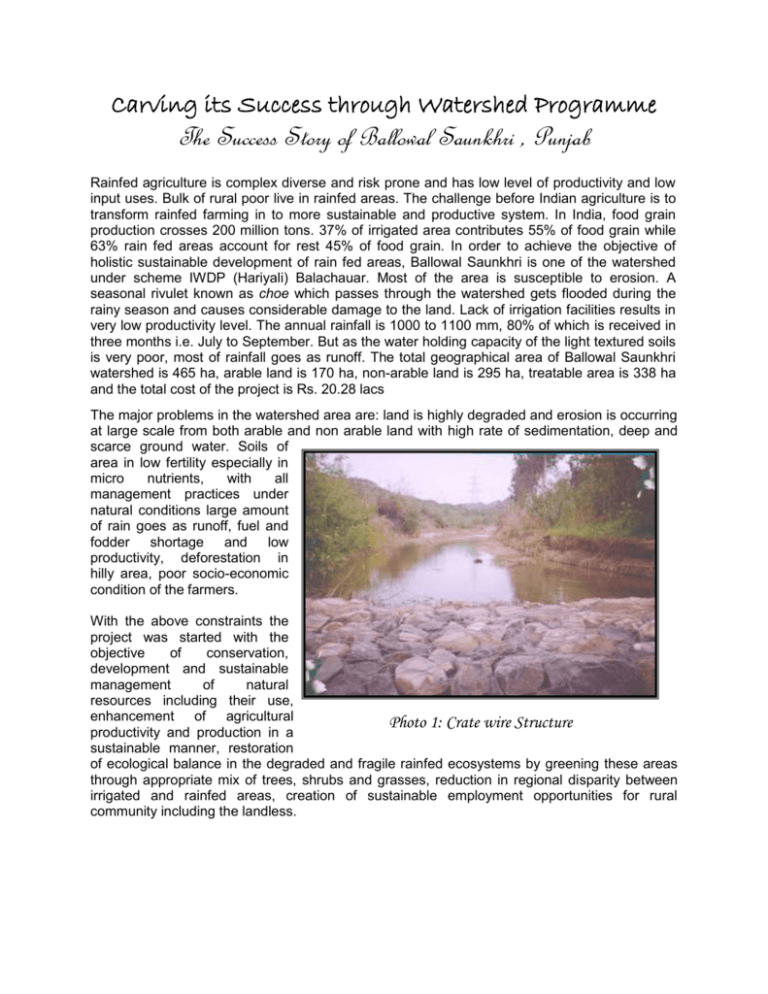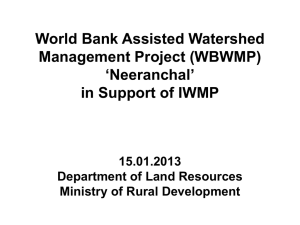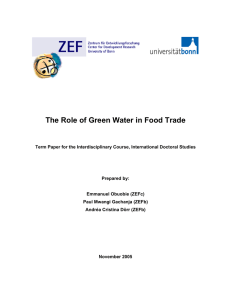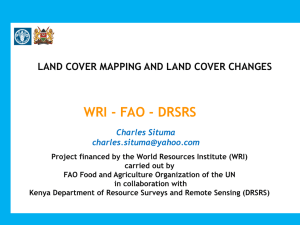Download-file - Department of Land Resources
advertisement

Carving its Success through Watershed Programme The Success Story of Ballowal Saunkhri , Punjab Rainfed agriculture is complex diverse and risk prone and has low level of productivity and low input uses. Bulk of rural poor live in rainfed areas. The challenge before Indian agriculture is to transform rainfed farming in to more sustainable and productive system. In India, food grain production crosses 200 million tons. 37% of irrigated area contributes 55% of food grain while 63% rain fed areas account for rest 45% of food grain. In order to achieve the objective of holistic sustainable development of rain fed areas, Ballowal Saunkhri is one of the watershed under scheme IWDP (Hariyali) Balachauar. Most of the area is susceptible to erosion. A seasonal rivulet known as choe which passes through the watershed gets flooded during the rainy season and causes considerable damage to the land. Lack of irrigation facilities results in very low productivity level. The annual rainfall is 1000 to 1100 mm, 80% of which is received in three months i.e. July to September. But as the water holding capacity of the light textured soils is very poor, most of rainfall goes as runoff. The total geographical area of Ballowal Saunkhri watershed is 465 ha, arable land is 170 ha, non-arable land is 295 ha, treatable area is 338 ha and the total cost of the project is Rs. 20.28 lacs The major problems in the watershed area are: land is highly degraded and erosion is occurring at large scale from both arable and non arable land with high rate of sedimentation, deep and scarce ground water. Soils of area in low fertility especially in micro nutrients, with all management practices under natural conditions large amount of rain goes as runoff, fuel and fodder shortage and low productivity, deforestation in hilly area, poor socio-economic condition of the farmers. With the above constraints the project was started with the objective of conservation, development and sustainable management of natural resources including their use, enhancement of agricultural Photo 1: Crate wire Structure productivity and production in a sustainable manner, restoration of ecological balance in the degraded and fragile rainfed ecosystems by greening these areas through appropriate mix of trees, shrubs and grasses, reduction in regional disparity between irrigated and rainfed areas, creation of sustainable employment opportunities for rural community including the landless. The implementation of this programme was done through Gram Panchayat in 2005-2006. Village Community participated in this project since its inception. Regular meetings of Gram Sabha/ Panchayat were conducted and works are planned as per their needs. Project activities were undertaken to slow down and reverse ecologic, degradation and to improve production and income from arable and nonarable areas. The drainage line treatment, steam bank stabilization and demonstration of different crops were the main activities carried out under this programme. Photo 2: Maize Crop Demonstration Five numbers of check dams, two crate wire structure, one barrier wall, for safe disposal of water three field to field drop structures were constructed in catchment and command area. Seeds of improved varieties of cereal crops, vegetable crops, fodder crops were distributed to the farmers to increase productivity. Agro forestry was also given the priority and plants of Amla, Subabul, Acasia sp. were distributed to the village people. To improve the condition of landless people, different kinds of trainings were imparted to start small enterprises and to increase their income by forming SHG/UG. These groups are trained in cutting, tailoring, embroidery, box-making, jam, squashmaking and rope-making etc. Photo 3: Seed Distribution Photo 4: SHG involved in Cutting and Tailoring These activities proved immensely useful within a short time. The improvement of economical standards of beneficiaries speaks volumes of the success of the programme. Life in this village has undergone a considerable change, thanks to this project. Rainwater which earlier goes as waste and causes havoc in the form of flash floods laden with heavy silt load to fertile land is controlled through the above works. The check dams have great impact on ground water recharge, thus increasing the moisture regime in catchment area and improving the vegetative cover. The perennial water supply in the drainage line which dried up in last five to six years due to deficient rains increased to a considerable extent. The discharge of perennial flow project increased from 0.6 to 1 cusec. Photo 5 & 6: Check Dam These activities have promoted vegetative growth which has stabilized gullies. The ground water table has come up approximately by 1.5 to 2.00 meter after the implementation of project. The villagers meet their daily requirement of fuel wood, fodder and water from the assets created by the project. The value of the land has increased by four times. Earlier village people used to migrate to far away places to earn their livelihood. Now, with sufficient water through perennial flow, they have started cultivating all types of crops including paddy in their fields. Farmers have diversified cropping pattern and go for cash crop like onion and earn about Rs. 50, 000 per acre. The wheat and maize yield increased by 20-25% with the assured irrigation. The impact of social fencing in the forest area reflected three times increase in grass yield. All plantations are doing very well with more than 70% success rate. Now, these groups have sufficient savings in their accounts. Besides this, one SHG of men is doing rope-making and selling it in the adjoining markets. The impact on the livestock population shows that the number of draft animals, goats and buffaloes increased. The feeding status of cattle has improved due to higher productivity of on farm fodder through fodder demonstration and milk yield increased from five liters to seven liters. Horticulture production also has increased by twenty percent from the pre-project yield. Photo 6: Onion as Cash Crop






